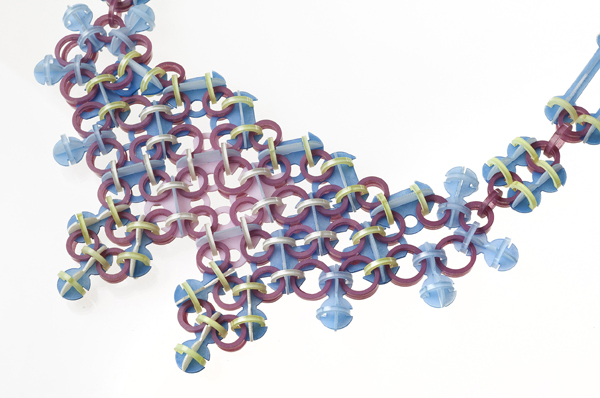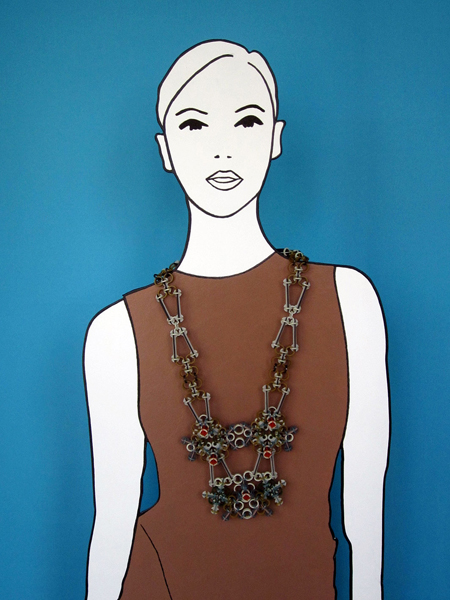
Missy Graff: How did you become a jeweler? Please tell me about your background.
Svenja John: I met a young goldsmith when I was on vacation on the Adriatic coast at the age of 14. I was fascinated by her natural glow and happiness. Her words were so passionate when she talked about her job that I decided, “This is exactly what I want to do!” It was neither a specific piece of jewelry, nor the concept of jewelry, that sparked my interest. It all started because of one person’s passion for making.
When I turned 16, I tried very hard to find an apprenticeship—against the will of my parents. At that time, it was an almost impossible desire. Without connections, none of my generation could reach this goal, simply due to the fact that there were too many people trying to enter the field.
I had to wait until 1985 to start my training as a jeweler and to become a student at the Staatliche Zeichenakademie in Hanau, Germany.

Missy Graff: How did you become a jeweler? Please tell me about your background.
Svenja John: I met a young goldsmith when I was on vacation on the Adriatic coast at the age of 14. I was fascinated by her natural glow and happiness. Her words were so passionate when she talked about her job that I decided, “This is exactly what I want to do!” It was neither a specific piece of jewelry, nor the concept of jewelry, that sparked my interest. It all started because of one person’s passion for making.
When I turned 16, I tried very hard to find an apprenticeship—against the will of my parents. At that time, it was an almost impossible desire. Without connections, none of my generation could reach this goal, simply due to the fact that there were too many people trying to enter the field.
I had to wait until 1985 to start my training as a jeweler and to become a student at the Staatliche Zeichenakademie in Hanau, Germany.
Tell me about the work you are presenting at Gallery Funaki. What, specifically, are you trying to accomplish with this series?
Svenja John: Last year I designed new elements. It only became possible to make these small parts after a leap in waterjet technologies (the technique I use for cutting the Makrofol® foil). So suddenly, three new components were added to my “jewelry construction kit” and I was able to create entirely new geometric constructions because of their “micro-dimensions.” At the same time, I was experimenting with various surfaces.
The new series comes with a variety of different surface characteristics: from a matte finish to a polychromatic finish. Metallic paint makes the new works sparkle like insect shells. The new color schemes are more earthy and gentle than in previous series. The fresh and smallish component parts made it possible for me to build more narrow patterns and structures, which form carpet-like, flickering color tableaus. These pieces are also a reflection of my current interest in fabric design. For the show at Gallery Funaki I also have some silk scarfs, where I translated my “jewelry pattern designs” into fabric designs.

You have developed a reputation for working with Makrofol®. Can you please explain what appealed to you about using this material in your work?
Svenja John: I like it because it is lightweight, stable, strong, and flexible. It absorbs paint and the surface can be sanded, plus it can be treated much like metal. I can cut it in simple or complex geometric shapes. The surface might be super smooth and shiny, or rough and velvety. It fits perfectly to my needs, my working methods, and my aesthetic philosophy.
Please describe your process.
Svenja John: I start with an inspiration. Nature or art—everything inspires me. After that, the design phase begins, with sketches and paper models emerging. Subsequently, I switch to CAD to generate the precise geometrical shapes I intend to use. For the production itself, I use waterjet technology, but the finishing of every single piece is done manually. I do the color design and the final assembly by hand.
How do viewers respond to the technological look of your jewelry? Does this make it difficult for them to appreciate how much handwork is involved?
Svenja John: The technical aspect of my jewelry particularly fascinates men, who are generally very enthusiastic about technology. Women are more attracted by the look and feel of the objects. In both cases, my work needs some extra explanation about the material, the creation process, and certainly the amount of work involved.
How do you see your work developing for future projects?

I want to push my jewelry engineering forward into unknown territories.
On your website you say that “Jewelry is a reaction to reality.” Can you elaborate?
Svenja John: We are living in modern, high-tech times, but a lot of jewelry designers still use medieval production methods. I want to build something new that deals with the new situation.
My customer observation also tells me that people who are interested in cutting-edge art, new design, and modern technology are slaphappy when they find jewelry that reflects their attitude.
You have been a successful maker for some time now. Do you have any advice for emerging artists just entering the field?
Svenja John: Work, work, work … Try to find your own style, your own way. Don’t clone other artist’s work.
Thank you.





